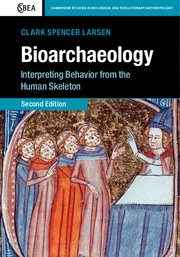Book contents
- Frontmatter
- Dedication
- Contents
- Preface to the Second Edition
- Preface to the First Edition
- 1 Introduction
- 2 Stress and deprivation during growth and development and adulthood
- 3 Exposure to infectious pathogens
- 4 Injury and violence
- 5 Activity patterns: 1. Articular degenerative conditions and musculoskeletal modifications
- 6 Activity patterns: 2. Structural adaptation
- 7 Masticatory and nonmasticatory functions: craniofacial adaptation to mechanical loading
- 8 Isotopic and elemental signatures of diet, nutrition, and life history
- 9 Biological distance and historical dimensions of skeletal variation
- 10 Bioarchaeological paleodemography: interpreting age-at-death structures
- 11 Bioarchaeology: skeletons in context
- References
- Index
- Plate section
2 - Stress and deprivation during growth and development and adulthood
Published online by Cambridge University Press: 05 April 2015
- Frontmatter
- Dedication
- Contents
- Preface to the Second Edition
- Preface to the First Edition
- 1 Introduction
- 2 Stress and deprivation during growth and development and adulthood
- 3 Exposure to infectious pathogens
- 4 Injury and violence
- 5 Activity patterns: 1. Articular degenerative conditions and musculoskeletal modifications
- 6 Activity patterns: 2. Structural adaptation
- 7 Masticatory and nonmasticatory functions: craniofacial adaptation to mechanical loading
- 8 Isotopic and elemental signatures of diet, nutrition, and life history
- 9 Biological distance and historical dimensions of skeletal variation
- 10 Bioarchaeological paleodemography: interpreting age-at-death structures
- 11 Bioarchaeology: skeletons in context
- References
- Index
- Plate section
Summary
Introduction
Physiological disruption resulting from impoverished environmental circumstances – “stress” – is central to the study of health and well-being and the reconstruction and understanding of health, adaptation, and behavior in both earlier and contemporary human societies. Stress involves disruption of homeostasis, or the maintenance of a constancy of conditions that keep the body’s internal environment stable. Stress is a product of three key factors, including (1) environmental constraints, (2) cultural systems, and (3) host resistance. Goodman and others (Goodman, 1991; Goodman & Armelagos, 1989; Goodman & Martin, 2002; Goodman, Martin et al., 1984, 1988; Klaus, 2012; Martin et al., 1991) modeled the interaction of these factors at both the individual and population levels (Figure 2.1). This model of health and context emphasizes the role of environment in providing both the resources necessary for survival and the stressors that may affect the health and well-being of a population, yet includes the profound influence of culture in health outcomes. Cultural systems serve as protective buffers from the environment, such as shelter and clothing as buffers against temperature extremes. Cultural systems can be highly effective at mitigating behaviors necessary for extraction of important nutrients and resources from the environment, thus supporting the ability to maintain stability. It appears impossible for the full spectrum of stressors in an environment to be buffered against; some inevitably slip through the filters of the cultural system. In these instances, the individual may exhibit a biological stress response observable at the tissue level (bones and teeth). Importantly, stress, buffering systems, and tissue-level responses are not linked by a simplistic, linear relationship. Instead, they can interact with and influence other variables within other levels of the model. Physiological disruption feeds directly back into environmental constraints and cultural systems. This model makes clear that health is a key variable in the adaptive process.
- Type
- Chapter
- Information
- BioarchaeologyInterpreting Behavior from the Human Skeleton, pp. 7 - 65Publisher: Cambridge University PressPrint publication year: 2015

